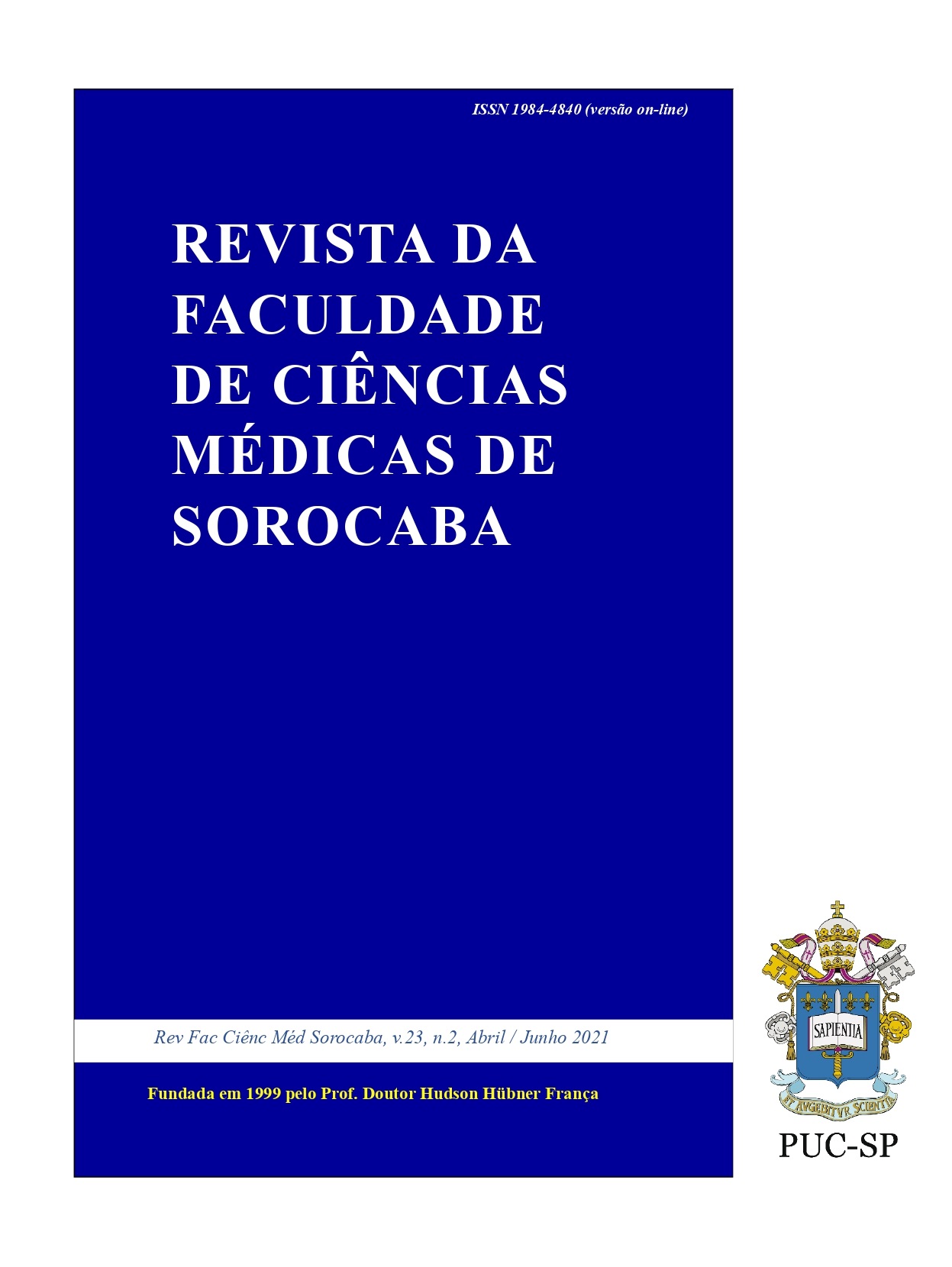Motor development assessment of hearing impaired babies
DOI:
https://doi.org/10.23925/1984-4840.2021v23i2a5Keywords:
Child Development, Hearing Loss, Motor Skills, Hearing Disorders, Infant, Newborn, Violência infanto juvenilAbstract
Objective: To evaluate the motor development of babies from zero to 18 months of age, with hearing impairment of any degree or type with the use of the AIMS. Method: Participated in the research, seven children, born term with age from 0 to 18, diagnosed with hearing impairment of any site or degree. Motor performance was assessed using the Alberta Infant Motor Scale (AIMS), composed of 58 items, 21 items in prone posture, 9 items in supine posture, 12 items in seated posture and 16 items in standing posture. Results: It was observed that three children presented suspicious motor performance and one presented motor performance ofrisk. Among these children, the postures with the greatest difficulty were prone, seated and standing. This evidence that the postures with greater difficulty were those that is needed greater sensorial integration, greater postural control and balance. Conclusion: The present study demonstrated that children with hearing impairment may present motor performance deficits, mainly in relation to postural control and balance. The AIMS proved to be a valid instrument for the evaluation of the motor performance of this population.
References
Rajendran V, Roy FG. An overview of motor skill performance and balance in hearing impaired children. Ital J Pediatr. 2011;37(1):33-7. doi: 10.1186/1824-7288-37-33.
Chadha NK, Chadha R, James AL. Why are children deaf? Paediatr Child Health. 2009;19(10):441-6. doi: 10.1016/j.paed.2009.05.001.
Lima TCS, Pereira MCC, Moras R. Influência da surdez no desenvolvimento motor e do equilíbrio em crianças. Braz J Mot Behav. 2011;6(1):16-23.
Godinho R, Keogh I, Eavey R. Perda auditiva genética. Rev Bras Otorrinolaringol, 2003;69(1):100-4. doi: 10.1590/S0034-72992003000100016
Bitner-Glindzicz M. Hereditary deafness and phenotyping in humans. Br Med Bull. 2002;63:73-94. doi: 10.1093/bmb/63.1.73.
Rajendran V, Roy FG, Jeevanantham D. Reliability of pediatric reach test in children with hearing impairment. Int J Pediatr Otorhinolaryngol. 2012;76(6):901-5. doi: 10.1016/j.ijporl.2012.02.068.
Gheysen F, Loots G, Van Waelvelde H. Motor development of deaf children with and without cochlear implants. J Deaf Stud Deaf Educ. 2007;13(2):215-24. doi: 10.1093/deafed/enm053.
De Kegel A, Maes L, Baetens T, Dhooge I, Van Waelvelde H. The influence of a vestibular dysfunction on the motor development of hearing-impaired children. Laryngoscope. 2012;122(12):2837-43. doi: 10.1002/lary.23529.
Wong TPS, Leung EYW, Poon CYC, Leung CYF, Lau BPH. Balance performance in children with unilateral and bilateral severe-to-profound-grade hearing impairment. Hong Kong Physiother J. 2013;31(2):81-7. doi: 10.1016/j.hkpj.2013.07.001
Rajendran V, Roy FG, Jeevanantham D. Postural control, motor skills, and health-related quality of life in children with hearing impairment: a systematic review. Eur Arch Otorhinolaryngol. 2012;269(4):1063-71. doi: 10.1007/s00405-011-1815-4.
Rajendran V, Roy FG, Jeevanantham D. Effect of exercise intervention on vestibular related impairments in hearing-impaired children. Alexandria J Med. 2013;49(1):7-12.
Livingstone N, Mcphillips M. Motor skill deficits in children with partial hearing. Dev Med Child Neurol. 2011;53(9):836-42. doi: 10.1111/j.1469-8749.2011.04001.x.
Fuentefria RN, Silveira RC, Procianoy RS. Motor development of preterm infants assessed by the Alberta Infant Motor Scale: systematic review article. J Pediatr. 2017;93(4):328-42. doi: 10.1016/j.jped.2017.03.003
Valentini NC, Saccani R. Brazilian Validation of the Alberta Infant Motor Scale. Phys Ther. 2012;92(3):440-8. doi: 10.2522/ptj.20110036.
Darrah J, Piper M, Watt MJ. Assessment of gross motor skills of at-risk infants: predictive validity of the Alberta Infant Motor Scale. Dev Med Child Neurol. 1998;40(7):485-91. doi: 10.1111/j.1469-8749.1998.tb15399.x.
Piper M, Darrah J. Motor assessment of the developing infant. Philadelphia (PA): WB Saunders; 1994.
Herrero D, Gonçalves H, Siqueira AAF, Abreu LC. Escalas de desenvolvimento motor em lactentes: Testofinfant Motor Performance e a Alberta Infant Motor Scale. Rev Bras Cresc Desenv Hum. 2011;21(1):122-32.
Valentini NC, Saccani R. Escala Motora Infantil de Alberta: validação para uma população gaúcha. Rev Paul Pediatr. 2011;29(2):231-8. doi: 10.1590/S0103-05822011000200015
Saccani R, Valentini NC. Reference curves for the Brazilian Alberta Infant Motor Scale:percentiles for clinical description and follow-up over time. J Pediatr. 2012;88(1):40-7. https://doi.org/10.2223/JPED.2142
Rine RM, Braswell J, Fisher D, Joyce K, Kalar K, Shaffer M. Improvement of motor development and postural control following intervention in children with sensorineural hearing loss and vestibular impairment. Int j Pediatr Otorhinolaryngol. 2004;68(9):1141-8. doi: 10.1016/j.ijporl.2004.04.007.
Lisboa TR, Jurkiewicz AL, Zeigelboim BS, Martins-Bassetto J, Klagenberg KF. Achados vestibulares em crianças deficientes auditivas. Arq Otorrinolaringol. 2005;9(4):271-9.
Schwab B, Kontorinis G. Influencing factors on the vestibular function of deaf children and adolescents - evaluation by means of dynamic posturography. Open Otorhinolaryngol J. 2011;5(1):01-09. doi: 10.2174/1874428101105010001.
Maes L, De Kegel A, Van Waelvelde H, Dhooge I. Association between vestibular function and motor performance in hearing-impaired children. Otol Neurotol. 2014;35(10):343-7. doi:10.1097/MAO.0000000000000597.
Ebrahimi AA, Movallali G, Jamshidi AA, Rahgozar M, Haghgoo HA. Postural control in deaf children. Acta Med Iran. 2017;55(2):115-22.
Rine RM, Cornwall G, Gan K, Locascio C, O'hare T, Robinson E, et al. Evidence of progressive delay of motor development in children with sensorineural hearing loss and concurrent vestibular dysfunction. Percpt Mot Skill. 2000;90(3):1101-12. doi: 10.2466/pms.2000.90.3c.1101.
Saccani R, Valentini NC. Controle postural em crianças nascidas a termo segundo a Alberta Infant Motor Scale: diferenças entre os sexos. J Hum Grow Develop. 2015;25(3):364-70. doi: 10.7322/jhgd.106014.
Saccani R, Valentini NC. Análise do desenvolvimento motor de crianças de zero a 18 meses de idade: representatividade dos itens da Alberta Infant Motor Scale por faixa etária e postura. Rev Bras Cresc Desenv Hum. 2010;20(3):711-22.
Downloads
Published
How to Cite
License
Copyright (c) 2023 Revista da Faculdade de Ciências Médicas de Sorocaba

This work is licensed under a Creative Commons Attribution-NonCommercial 4.0 International License.
Os autores no momento da submissão transferem os direitos autorais, assim, os manuscritos publicados passam a ser propriedade da revista.
O conteúdo do periódico está licenciado sob uma Licença Creative Commons 4.0, esta licença permite o livre acesso imediato ao trabalho e que qualquer usuário leia, baixe, copie, distribua, imprima, pesquise ou vincule aos textos completos dos artigos, rastreando-os para indexação, passá-los como dados para o software, ou usá-los para qualquer outra finalidade legal.

 Este obra está licenciada com uma Licença
Este obra está licenciada com uma Licença 